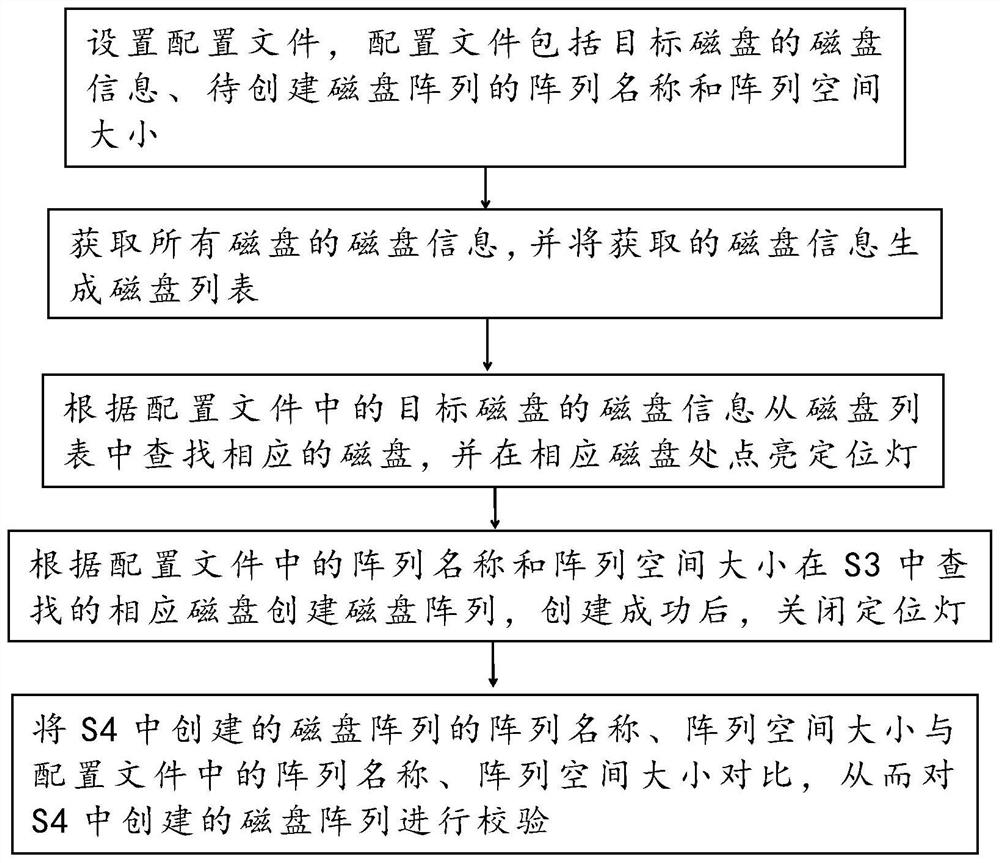A method, device, equipment and storage medium for automatically creating disk arrays
A disk array and automatic creation technology, applied in the input/output process of data processing, instruments, input/output to record carriers, etc., can solve the problem of manpower and time consumption, increase the error rate of manual input, reduce R&D testing, and production efficiency and other problems, to achieve the effect of simple structure, prominent substantive features, and reliable design principles
- Summary
- Abstract
- Description
- Claims
- Application Information
AI Technical Summary
Problems solved by technology
Method used
Image
Examples
Embodiment 1
[0029] Embodiment 1, this embodiment is carried out under the Linux OS system. Please refer to figure 1 , the specific detection steps are as follows:
[0030] S1. Set the configuration file, the configuration file includes the disk information of the target disk, the array name and the size of the array space of the disk array to be created;
[0031] S2. Obtain disk information of all disks, and generate a disk list from the obtained disk information;
[0032] S3. Find the corresponding disk from the disk list according to the disk information of the target disk in the configuration file, and turn on the positioning light at the corresponding disk;
[0033] S4. Create a disk array according to the array name in the configuration file and the size of the array space to find the corresponding disk in S3. After the creation is successful, turn off the positioning light;
[0034] S5. Compare the array name and array space size of the disk array created in S4 with the array nam...
Embodiment 2
[0035] Embodiment 2, this embodiment is carried out under the Linux OS system. Please refer to figure 2 , the specific detection steps are as follows:
[0036] S1. Run the script VD_create.sh to set the target disk PD information, array name and array space size (default full disk space), such as VD_create.sh RAID5 1-3 500G or VD_create.sh RAID5 1-3.
[0037] S2. Obtain all the PD information of the physical disk and save it to PD_list.txt.
[0038] S3. Select a disk from the disk list generated in step S2 according to the target disk information input in step S1, and turn on the positioning light.
[0039] S4. Create a RAID (disk array) for the disk selected in step S3, select the input in step S1 to set the name of the RAID array and the size of the array space, and create a RAID array.
[0040] S5. Prompting success after successful creation, and displaying the name and size of the created RAID array, and turning off the corresponding physical disk positioning light of ...
PUM
 Login to View More
Login to View More Abstract
Description
Claims
Application Information
 Login to View More
Login to View More - R&D
- Intellectual Property
- Life Sciences
- Materials
- Tech Scout
- Unparalleled Data Quality
- Higher Quality Content
- 60% Fewer Hallucinations
Browse by: Latest US Patents, China's latest patents, Technical Efficacy Thesaurus, Application Domain, Technology Topic, Popular Technical Reports.
© 2025 PatSnap. All rights reserved.Legal|Privacy policy|Modern Slavery Act Transparency Statement|Sitemap|About US| Contact US: help@patsnap.com


